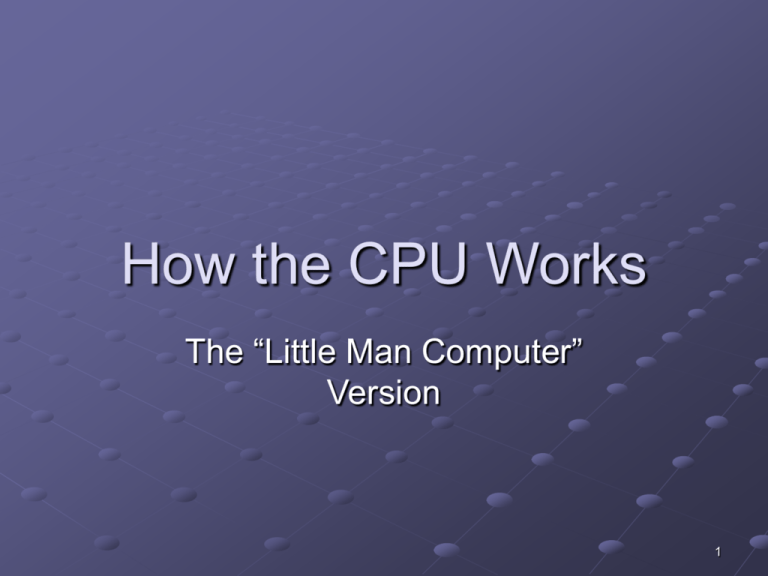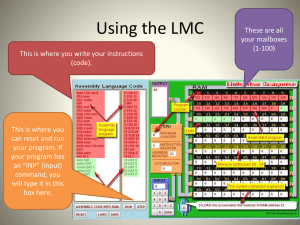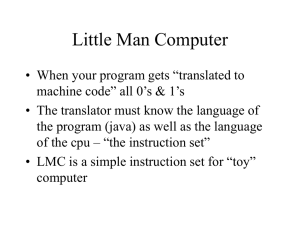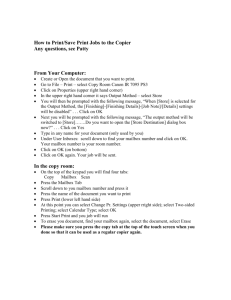Hardware Basics
advertisement

How the CPU Works The “Little Man Computer” Version 1 Download the tutorial You can download your own copy of the Little Man Computer simulation from the University of Hertfordshire Start the download now Save it to your hard drive We will use it shortly The link: http://www.herts.ac.uk/lis/ltdu_temp/ltdu/projects/ mm5/# You can access this link directly from my website 2 The Little Man Computer 3 LMC Instruction Codes LOAD instruction – op code 1 The Little Man goes to the mailbox specified Reads the three-digit number in the mailbox Puts that into the Calculator Note: The number in the mailbox is unchanged The number in the calculator is replaced by the new number 4 LMC Instruction Codes STORE instruction – op code 2 The Little Man goes to the Calculator and reads the number there He writes the number down on a slip of paper and puts it into the mailbox specified in the instructions Note: The number in the Calculator does not change The number in the Mailbox is replaced with the new value 5 LMC Instruction Codes ADD instruction – op code 3 The Little Man walks over to the mailbox address specified in the instructions He reads the number and adds this number to the number already in the calculator. Note: The number in the mailbox is unchanged 6 LMC Instruction Codes SUBTRACTION – op code 4 Same as the ADD instruction, except the number is subtracted For this model we will assume that the Little Man handles negative numbers correctly, though we will not deal with it here. Note: The number in the mailbox is left unchanged 7 LMC Instruction Codes INPUT (or READ) – op code 5, “address” 00 (the 00 is ignored for this special instruction code) The Little Man gets a slip of paper in from the in-basket He types this number into the calculator Each INPUT instruction handles only 1 slip of paper The Little Man will ignore the address portion of this code 8 LMC Instruction Codes OUTPUT (or PRINT) – op code 6, “address” 00 (the 00 is ignored for this special instruction code) The Little Man walks to the calculator and writes down the number on a slip of paper This slip is put in to the out basket Each OUTPUT instruction places 1 piece of paper in the out basket The Little Man will ignore the address portion of this code 9 LMC Instruction Codes COFFEE BREAK (or HALT) – op code 7 The Little Man takes a break. He will ignore the address portion of the instruction 10 A Simple Program A few items We need to store the instructions somewhere We need a method to tell the Little Man where to find the particular instructions that he is supposed to perform at any given time 11 A Simple Program Assumed Solutions Assume that the instructions are stored in the mailbox starting at mailbox number 00 The Little Man will perform instructions by looking at the value in the instruction location counter and execute the instruction found in the mailbox whose address has that value 12 A Simple Program Assumed Solutions Each time the LM completes and instruction, he will increment the Instruction Location Counter and do the instruction specified by the counter 13 A Simple Program Look at a program where the USER uses the Little Man Computer to add two numbers. The User will place two numbers in the in basket The sum of the two will appear as a result in the out basket 14 A Simple Program INPUT 500 The first step is to give the LM access to the data This instruction has the LM read the first number from the in basket in to the calculator 15 A Simple Program STORE 99 299 It is not possible for the LM to simply read another number into the calculator. It would destroy the first number We must save the first number somewhere Mailbox 99 is chosen so that we don’t have any conflicts with other data or programs Discuss this 16 A Simple Program INPUT The LM reads the second number into the calculator ADD 500 399 We do not need to save the 2nd number in the example, but we could have. The 1st number from mailbox 99 is added to the 2nd number in the calculator 17 A Simple Program OUTPUT The LM puts the result in to the out basket COFFEE BREAK 600 700 The program terminates Note: These instructions are stored sequentially starting from mailbox 00. This is so we could run the program again 18 A Simple Program Code Summary Step 00 01 02 03 04 05 99 Mailbox code Instruction description 500 299 500 399 600 700 INPUT STORE DATA INPUT 2ND # ADD 1ST # TO it OUTPUT RESULT STOP DATA 19 Run the CPU Simulator Now you try it. Do the sample program included with the simulation Write your own program (and show me that they work) Write a program to add 3 numbers Write a program that correctly calculates x + y + z – a – b (Ex. 1 + 2 + 3 – 4 – 5 = -3) For the bold and intelligent ones: Write the last program only using 2 mailboxes! 21 How the CPU Works A More Complex View 22 Overview We saw in the “Little Man Computer” a simplified version of how a CPU works. Memory, the Control Unit, the Accumulator (calculator) were all located in the same area Decimal system used for communication of instructions Memory was limited to 100 “mailboxes” 23 CPU Components 3 Major Parts Arithmetic/Logic Unit (ALU) Control Unit (CU) Memory The ALU & CU are known as the Central Processing Unit 24 Block Diagram of System CPU ALU Control Unit Program Counter Memory I/O 25 Direct Comparison of LMC & CPU Control Unit ALU I/O Interface Memory Program Counter 26 CPU ALU Control Unit Program Counter I/O Memory Arithmetic/ Logic Unit (ALU) The component where data is held temporarily Calculations occur here It knows how to perform operations such as ADD, SUB, LOAD, STORE, SHIFT. It knows the commands that make up the machine language of the CPU It is the calculator 27 CPU ALU Control Unit Program Counter Memory Control Unit I/O Interprets and controls the execution of instructions This control corresponds to the “fetchexecute” cycle The fetch cycle gets the instructions The execute cycle does the work specified in the instruction Note 28 CPU ALU Control Unit Program Counter Memory Registers I/O “A Register is a single, permanent storage location within the CPU used for a PARTICULAR, defined purpose.” “A register is used to hold a binary value temporarily for storage, for manipulation, and/or for simple calculations.” Registers have special addresses 29 The End… 30







